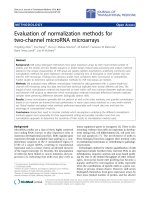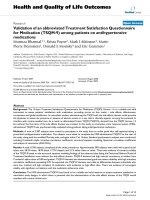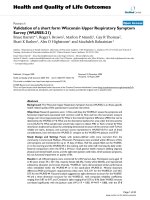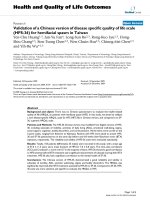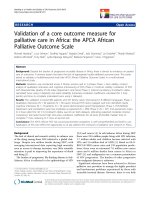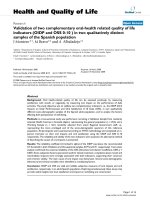báo cáo hóa học:" Validation of an English version of the Child-OIDP index, an oral health-related quality of life measure for children" pot
Bạn đang xem bản rút gọn của tài liệu. Xem và tải ngay bản đầy đủ của tài liệu tại đây (232.17 KB, 7 trang )
BioMed Central
Page 1 of 7
(page number not for citation purposes)
Health and Quality of Life Outcomes
Open Access
Research
Validation of an English version of the Child-OIDP index, an oral
health-related quality of life measure for children
Huda Yusuf
1
, Sudaduang Gherunpong
2
, Aubrey Sheiham
1
and
Georgios Tsakos*
1
Address:
1
Department of Epidemiology and Public Health, University College London, UK and
2
Department of Community Dentistry, Faculty of
Dentistry, Chulalongkorn University. Bangkok, Thailand
Email: Huda Yusuf - ; Sudaduang Gherunpong - ;
Aubrey Sheiham - ; Georgios Tsakos* -
* Corresponding author
Abstract
Background: To evaluate the psychometric properties of the Child-OIDP for use among children
in the UK and report on the prevalence of oral impacts in a sample of schoolchildren in
Westminster.
Methods: Children aged 10–11 years in the final year of primary school (year 6) were selected
from seven schools where annual screenings are carried out. A total of 228 children participated
(99% response rate). A clinical examination was conducted followed by a questionnaire designed
to measure oral health-related quality of life in children, namely the Child-OIDP. The psychometric
properties of the Child-OIDP were evaluated in terms of face, content and concurrent validity in
addition to internal and test-retest reliability.
Results: The Child-OIDP revealed excellent validity and good reliability. Weighted Kappa was
0.82. Cronbach's alpha coefficient was 0.58. The index showed significant associations with
perceived oral treatment needs and perceived satisfaction with mouth and oral health status (p <
0.001).
Conclusion: This study has demonstrated that the Child-OIDP is a valid and reliable index to be
used among 10–11 year old schoolchildren in the UK.
Background
The concept of need is central to planning, provision and
evaluation of health care services. Traditionally, need has
been estimated by using professionally based measures,
known as normative need. Although normative need is
important, it mainly reflects the clinical aspects of illness.
However, subjective measures of health are important
too, because they provide insights into how people feel
and how satisfied they are with their quality of life [1].
Health-related quality of life instruments should therefore
be used in conjunction with clinical measures.
A child's oral health can impact on eating, smiling, speak-
ing and socialising. Oral conditions, such as dental caries
may result in pain, which in turn may lead to conse-
quences on a child's daily life such as taking time off from
school or difficulty eating. Facial appearance and its rela-
tion to body image, self-esteem and emotional well-being
Published: 01 July 2006
Health and Quality of Life Outcomes 2006, 4:38 doi:10.1186/1477-7525-4-38
Received: 22 March 2006
Accepted: 01 July 2006
This article is available from: />© 2006 Yusuf et al; licensee BioMed Central Ltd.
This is an Open Access article distributed under the terms of the Creative Commons Attribution License ( />),
which permits unrestricted use, distribution, and reproduction in any medium, provided the original work is properly cited.
Health and Quality of Life Outcomes 2006, 4:38 />Page 2 of 7
(page number not for citation purposes)
also play important roles in social interaction. Measuring
oral impacts in children is particularly relevant, as it will
aid researchers and policymakers in assessing need, prior-
itising care and evaluating treatment outcomes [2]. Fur-
thermore, children do not live in isolation; children's oral
conditions may affect their siblings and parents. Studies
using the lifecourse approach have highlighted that dental
conditions have wider repercussions not only for the
present but also in adulthood [3]. These issues have stim-
ulated current interest in paediatric research related to
quality of life.
Although there has been an increase in the development
and use of oral health related quality of life measures in
the past two decades, most have been developed for use in
adults. Very few have been developed specifically for or
used in children [4-7]. This is because there are numerous
methodological and conceptual problems when develop-
ing paediatric health-related quality of life measures. For
example, children's understanding of illness and health is
age dependent due to social, language, emotional, and
cognitive development [8]. Children undergo changes in
psychosocial awareness, physical changes in dental and
facial features, as well as cognitive developments [5,8].
These occur at certain stages of life and hence measuring
and comparing these changes at different ages may be dif-
ficult. This study has been carried out in an attempt to
contribute to the development and application of valid
and reliable oral health-related quality of life measures in
children at a particular age.
The Child Oral Impacts on Daily Performances (Child-
OIDP) was developed and tested among 11–12 year old
Thai children [5] to assess the prevalence and severity of
impacts and factors related to the impacts. This index can
also be used to assess oral health needs in population sur-
veys, thus making it useful for planning services. Its scor-
ing system enables health planners to prioritise dental
care according to the severity of impact scores of subjects.
It has been found to be a valid and reliable index among
children in Thailand [5] and in France [9]. Its use in differ-
ent countries and age groups is advocated. In order to val-
idly use the instrument in the UK, it is important to
investigate its psychometric properties. The main objec-
tive of this study is to evaluate the psychometric properties
of the Child-OIDP for use among children in UK. In addi-
tion, we will also report on the prevalence of oral impacts
in a sample of 10–11 year old schoolchildren in Westmin-
ster, London.
Methods
The study was carried out on an opportunity sample
selected from children attending state schools in West-
minster, London. This is an inner-city London area with a
culturally diverse population. Seven state schools that
were covered by the dental clinic, where the principal
author (HY) worked, were selected. All seven primary
schools were chosen for the study. The schools were tar-
geted annually for dental screening and the data collec-
tion in each school was carried out at the end of the school
screening. The sample included 10–11 year old children
in the last year of primary school (year 6). All 232 boys
and girls in year 6 were asked to participate.
Before the main study, a pilot study was carried out on
children of the same age in a different area in London. It
confirmed the feasibility of the methodology with only
minor modifications of the wording of the questionnaire.
The study had two aspects: a clinical examination fol-
lowed by the administration of a questionnaire. Clinical
examinations were carried out by the principal investiga-
tor (HY) with the help of a dental nurse, who acted as a
recorder for the examination and was further involved in
the administration of the questionnaire. The administra-
tion of the questionnaire involved face-to-face interview
with each child on an individual basis. We will not
present the clinical results in this publication. The socio-
demographic and oral health-related quality of life data
were collected through interview-administered question-
naires. Re-examinations were carried out (one week later)
on oral health-related quality of life (OHRQoL) data on
18 children, representing 8% of the sample.
The Child-OIDP questionnaire was the measure of oral-
health related quality of life used in this study [5]. It is
derived from the OIDP with wording modifications
addressing children's capability in relation to their intel-
lectual, cognitive and language development. It is based
on a modified version of WHO's International Classifica-
tion of Impairments, Disabilities and Handicaps [10,11].
The Child-OIDP assesses oral impacts on the following
daily performances: eating, speaking, cleaning teeth, smil-
ing, emotional stability, relaxing, doing schoolwork, and
social contact. In the Thai version, pictures were used to
portray the impacts for better understanding. These were
not used in this study, as the pilot study confirmed that
children were able to understand the relevance of the
impacts without needing pictures. Participants were asked
about the frequency and severity of each impact on Likert
scales (0 to 3)*.
Every time a scale is used in a new context or with a differ-
ent population group, it is necessary to test its psychomet-
ric properties [12]. The psychometric testing involved the
assessment of internal and test-retest reliability in addi-
tion to face, content and concurrent validity. Face validity
refers to whether the items appear to be measuring what
they are supposed to measure. Content validity is similar
to face validity, the main difference is that a panel of
Health and Quality of Life Outcomes 2006, 4:38 />Page 3 of 7
(page number not for citation purposes)
experts examines the instrument and determines the
degree to which its items address the topics the instru-
ment is supposed to measure. This means looking at read-
ing level and vocabulary [12]. Since there is no gold
standard OHRQoL index, criterion validity is not assessed.
In such a case, it is recommended that the validation proc-
ess should rely heavily on concurrent validity [13] which
examines a logical hypothesis by testing the index against
a proxy measure of a similar concept. To assess the concur-
rent validity of the Child-OIDP, a number of questions
were asked on perceived oral health and satisfaction with
mouth, and the perceived need for dental treatment.
Ethical approval was given by the Local Ethics Committee.
Parents and head teachers were sent information sheets
regarding the purpose of the study. Negative consent was
sought from the parents, as this was common practice for
school dental inspections. In addition, positive consent
was sought from the children.
Data analysis
Internal reliability was tested by using the standardised
Cronbach alpha coefficient, as well as item-total and
inter-item correlations. Test-retest reliability was tested by
using the weighted kappa for categories of the Child-
OIDP scores, as well as the intra-class correlation coeffi-
cient (ICC) using the two way random effects model for
the Child-OIDP score.
Face and content validity were empirically tested before
and after the pilot study. The frequency distribution for
the Child-OIDP scores is skewed and hence non-paramet-
ric testing was applied. Consequently, testing for concur-
rent validity referred to the relationship between the
Child-OIDP and the following variables:
Perceived satisfaction with mouth (re-categorised into
three categories; "low", "moderate" and "high") using the
Kruskal-Wallis test, perceived oral health and treatment
need (re-categorised into binary variables) using the
Mann-Whitney test.
The data were analysed using the SPSS statistical package.
The cut-off level for statistical significance was set at 0.05.
Results
232 children were invited to participate in the study and
228 agreed. Three children did not give consent and 1
child did not speak English. The response rate was 99%
(228/231 children).
Overall, 40.4% of participants reported at least one oral
impact affecting their daily performance in the past three
months (Table 1). The most prevalent impact was diffi-
culty eating (23.2% of children), followed by impacts on
cleaning teeth (18%), emotional stability (11.8%) and
smiling (9.6%). Doing schoolwork and social contact
were the least prevalent impacts, occurring in 1.8% and
2.2% of children in the sample.
In terms of internal reliability, the inter-item correlation
coefficients among the 8 items of Child-OIDP ranged
from -0.04, which represented the relationship between
sleeping and cleaning, to 0.54 (Table 2). The vast majority
of the inter-item correlations were positive, but very few
correlations were negative, but very close to zero. The cor-
rected item-total correlation coefficients ranged from 0.12
(doing homework, social contact) to 0.49, which related
to emotional stability (Table 3). The standardised Cron-
bach's alpha coefficient was 0.58. Furthermore, the alpha
coefficient did not increase when any of the items were
deleted.
Test-retest reliability is the degree of agreement between
two measurements taken at two different points in time
using the same scale and with the same respondents; this
provides an estimation of the degree to which the results
are reproducible [14]. In this study, the weighted kappa
statistic was 0.82 and the ICC was 0.88.
Face and content validity of the Child-OIDP were estab-
lished prior to the main study. During the pilot study, the
Child-OIDP questions were administered to a sample of
20 children. In addition, the relevance and understanding
of the questionnaire was verified through a discussion
with the children and their teacher. As a result, very minor
changes were introduced prior to the main study.
In relation to concurrent validity (Table 4), those with a
higher Child-OIDP score were less likely to be satisfied
with their mouth (p < 0.001). Similarly, those who per-
ceived their oral health as fair or poor are more likely to
have a higher Child-OIDP when compared to those that
perceived their oral health as "good", "very good" or
"excellent" (p = 0.01). Furthermore, children who per-
ceived a need for dental treatment had much higher
Child-OIDP scores than those who did not have perceived
need (p < 0.001).
Discussion
This study showed that the Child-OIDP index has good
reliability and excellent validity among a culturally
diverse sample of 10–11 year-old children in Westmin-
ster, thus indicating its applicability for child populations
of similar ages in UK.
Test-retest reliability was confirmed as both the weighted
kappa (0.82) and the ICC (0.88) indicated very good reli-
ability. In terms of internal reliability analysis, the major-
ity of corrected item-total correlations were above the
Health and Quality of Life Outcomes 2006, 4:38 />Page 4 of 7
(page number not for citation purposes)
recommended level of 0.2 [15], with the exception of
those for social contact and doing schoolwork. Also,
nearly all inter-item correlations were positive and no cor-
relation was high enough for any item to be redundant.
Some of the inter-item correlations were negative, but very
close to zero, most of which related to doing schoolwork
and social contact. However, this should be expected, as
the same two items ('social contact' and 'doing school-
work') were also the least prevalent. This might be due to
the fact that children in this particular age group do not
attach much importance to those activities. An alternative
explanation is that enjoying contact with people might be
an inherently unstable construct to the children, which
varies with time [16].
The Cronbach alpha coefficient was 0.58 and this value
did not increase when any item was deleted. This value
may be questioned as some authors have recommended a
value of 0.70 [15]. But, when examining internal reliabil-
ity coefficients, scepticism is advised regarding what they
are supposed to demonstrate, with a close examination of
the item and subject conditions [17]. The criterion for
"adequate" internal reliability depends on the purpose of
the measure. For purposes of group comparisons, reliabil-
ity does not have to be as high as it would have to be to
make individual comparisons [18]. Reliability of 0.5 or
above is considered to be acceptable [19-21].
On an important methodological point, the over-reliance
on the actual value of Cronbach alpha for the assessment
of reliability of an index should be open to further debate.
This value is dependent not only on the magnitude of the
correlation among the items but also on the number of
items in the scale [12]. A scale can be made to look more
homogenous and obtain high value of average internal
correlation (Cronbach alpha) simply be doubling the
number of items or adding a similar set of items [18].
Lower values of Cronbach alpha can be expected from
shorter scales [22]. The Child-OIDP, which has few items
(less than 10), falls into this category. Thus, a question-
naire with fewer items will be less internally consistent as
each item is less relevant to the others and will result in
patient scores that fluctuate more, due to random
responses, in comparison to a longer instrument where a
few items can be closely related (e.g. eating, drinking and
chewing) and thus obtain a high value of Cronbach alpha
[23]. Hence, it is not sufficient to simply compare Cron-
bach alpha levels when looking for a reliable instrument,
because the alpha level will be lower in instruments with
fewer items [12,22,24]. Higher reliability coefficients cost
more than lower ones since they require more items. This
poses a trade off between a brief and internally consistent
measure that could be taken into a consideration in order
to improve the practicality of an index. This is especially
so for indices designed to be used at a population level
Table 1: Prevalence of oral impacts on daily performances (Child-OIDP)
Oral Impacts on Daily Performances % of children (N = 228)
Eating 23.2%
Cleaning teeth 18.0%
Speaking 3.9%
Smiling 9.6%
Relaxing/sleeping/ 7.0%
Emotional stability 11.8%
Doing Schoolwork 1.8%
Social contact 2.2%
Any Impact 40.4%
Table 2: Reliability analysis: Inter-item correlation for the Child-OIDP
Performance
Scores
Eating Emotion Cleaning Schoolwork Speaking Social
Contact
Smiling Sleeping
Eating 1.00
Emotion 0.41 1.00
Cleaning 0.30 0.36 1.00
Schoolwork 0.16 0.15 0.00 1.00
Speaking 0.00 0.04 0.14 -0.01 1.00
Social
Contact
0.07 0.07 0.03 -0.01 0.26 1.00
Smiling 0.16 0.35 0.25 -0.01 0.27 -0.03 1.00
Sleeping 0.14 0.05 -0.04 0.12 0.54 0.19 0.10 1.00
Health and Quality of Life Outcomes 2006, 4:38 />Page 5 of 7
(page number not for citation purposes)
and to obtain good cooperation of subjects, children in
particular. They may not cooperate well with a long index.
It is important that OHRQoL measures should be as brief
as possible and user friendly in order to reduce the time
and cost burden of to researchers and children, yet captur-
ing all the dimensions related to OHRQoL [25,26].
The psychometric properties of instruments are depend-
ent on the linguistic and cultural context in which they are
used, especially as health is dynamic and depends on the
environment. The face and content validity of the Child-
OIDP was established in the pilot study. Concurrent
validity was tested demonstrating significant relationships
between Child-OIDP scores and satisfaction with mouth,
perceived oral health and perceived dental treatment
need. These results emphasise that perceptions of oral
health and satisfaction with the mouth are strongly asso-
ciated with oral health-related quality of life; the better the
perception, the lower the prevalence of oral impacts.
Overall, 40% of children had an oral health related
impact on their daily performance. This is lower than in
other studies of similar ages [5,9,27]. This could partly be
explained by different disease levels, age groups, culture
and location of the sample. The most prevalent impact
was 'eating' which was consistent with findings on other
populations using the OIDP and Child-OIDP [5,9,27].
The importance of oral health-related quality of life is par-
ticularly relevant for children. Their perceptions are
important as a number of their social and psychological
coping skills are still developing. Because of their stage of
development, they may be more sensitive to a variety of
impacts, such as appearance, on their health-related qual-
ity of life. These impacts will affect their current quality of
life and psychological development and may ultimately
result in influencing their social skills and education [3,7].
An understanding of OHRQoL can only be achieved by
asking the child about the impact of dental conditions on
their quality of life. Although this may be complicated in
children due to developmental issues [8], the use of pae-
diatric OHRQoL measures should be encouraged in order
to gain insights into the full impacts of dental illness and
health.
Children have been regarded as unreliable respondents
and a number of studies have relied on using proxy meas-
ures. Hence data was collected from their parents. This
approach is not free from limitations, especially in rela-
tion to its accuracy. Children and parents may not share
Table 3: Reliability analysis: Corrected item-total correlations
Items Corrected item-total correlations Alpha item if deleted
Cleaning teeth 0.36 0.51
Social contact 0.13 0.58
Eating 0.38 0.51
Emotional stability 0.49 0.47
Doing schoolwork 0.12 0.58
Sleeping 0.20 0.56
Smiling 0.34 0.52
Speaking 0.29 0.55
Standardised item alpha = 0.58
Table 4: Concurrent validity tests for the Child-OIDP: comparison of Child-OIDP scores between different categories of related
outcome variables
Variables (Categories) N. Child-OIDP Quartiles P-value
Perceived Oral Health
1
Fair or poor 91 (0, 1.4, 5.6) 0.01
Good, very good or excellent 137 (0, 0, 2.8)
Perceived satisfaction with
mouth
2
Dissatisfied 29 (0, 5.56, 11.81) <0.001
Neither/nor 53 (0, 0, 4.17)
Satisfied 146 (0, 0, 2.78)
Perceived Dental Treatment
Need
1
Not Present 150 (0, 0, 1.7) <0.001
Present 78 (0, 1.4, 8.3)
1
Mann-Whitney,
2
Kruskal-Wallis
Health and Quality of Life Outcomes 2006, 4:38 />Page 6 of 7
(page number not for citation purposes)
the same views about illness and health [6]. Consequently
it has been advocated that children should be asked
directly about the impact of illness and health on their
daily lives [28]. Another important consideration is the
mode of administration of quality of life measures. Self-
completed questionnaires are cost effective but may be
more suitable for older children. Face to face interviews
can be used on younger children. This is more costly but
compliance is higher. Hence, there should be a balance
between being as comprehensive as possible yet ensuring
that a measure is sufficiently succinct so that the instru-
ment can be practically administered [29].
Conclusion
This study has shown that a brief, direct, interviewer-
administered OHRQoL instrument can provide useful
data on the oral health-related quality of life of children.
Overall, the Child-OIDP showed good reliability and
excellent validity. Oral health-related quality of life meas-
urements are aimed at complementing clinical indicators,
which has a two-fold advantage. They are useful in mov-
ing the focus of provision of health services to patient's
perceived needs and quality of life. Thus the provision of
dental care on children should address not just their clin-
ical dental need, but give attention to their sociodental
needs, taking also into consideration their perceptions in
terms of the impact of the oral conditions on their daily
life. Also, dental professionals and the public can gain a
better understanding of the origins of illnesses. Thus
patients would be more likely to engage in health promot-
ing behaviour patterns [30]. This is particularly important
in children as their experiences in early life may influence
their future attitudes and behaviours.
Competing interests
The author(s) declare that they have no competing inter-
ests.
Authors' contributions
HY was responsible for the literature review, management
and organisation of the study, methodology with assist-
ance from GT, AS, DG, data collection, data input, data
analysis and interpretation with assistance from GT and
AS. SG was consulted for methodology and analysis and
revised the manuscript for its intellectual content. AS con-
tributed to the conception, design and interpretation of
the study and critically revised the manuscript and gave
final approval for the final version to be published. GT
was responsible for substantial contribution to the con-
ception and design of the study, supervised data analysis
and interpretation, critically revised the manuscript and
gave final approval.
Acknowledgements
We would like to thank children, parents and school staff and the Commu-
nity Dental Service in Westminster.
* A full version of the questionnaire can be provided by the authors on
request.
References
1. Bowling A: Health-related quality of life: a discussion of the
concept, its use and measurement. In Measuring Disease Edited
by: Bowling A Buckingham, UK, Open University Press; 1995:1-19.
2. Sheiham A, Maizels J, Cushing A: The concept of need in dental
care. International Dental Journal 1982, 32:265-270.
3. Reisine S: Dental health and public policy; the social impact of
dental disease. American Journal of Public Health 1985, 75:27-30.
4. De Oliveira M, Sheiham A: The relationship between normative
orthodontic need and oral health-related quality of life. Com-
munity Dentistry and Oral Epidemiology 2006, 31:426-436.
5. Gherunpong S, Tsakos G, Sheiham A: Developing an OHRQoL
index for children, the Child-OIDP. Community Dental Health
2004, 21:161-169.
6. Jokovic A, Locker D, Stephens M, Kenny M, Tompson B, Guyatt G:
Validity and reliability of a questionnaire for measuring child
oral-health related quality of life. Journal of Dental Research 2002,
81:459-463.
7. Locker D, Jokovic A, Stephens M, Kennedy D, Tompson B, Guyatt G:
Family impact of child oral and oro-facial conditions. Commu-
nity Dentistry and Oral Epidemiology 2002, 30:438-448.
8. Pal D: Quality of life assessment in children; a review concep-
tual and methodological issues in multi-dimensional health
status measures. Journal of Epidemiology and Community Health
1996, 50:397-400.
9. Tubert-Geannin S, Pegon-Machat E, Griemeau-Richard C, Lecuyer M,
Tsakos G: Validation of a French version of the Child-OIDP
index. European Journal of Oral Sciences 2005, 113:355-362.
10. Locker D: Measuring oral health: a conceptual framework.
Community Dental Health 1988, 5:3-18.
11. Organisation WH: International Classification of impairments,
disabilities and handicaps. Geneva, World Health Organisation;
1980.
12. Streiner D, Norman G: Health Measurement Scales. A practical guide to
their development and use. 2nd edition. New York, Oxford University
Press; 2000.
13. McDowell I, Newall C: Measuring health; a guide to rating scales and
questionnaires 2nd edition. New York, Oxford University Press; 1987.
14. Altman D: Practical Statistics for Medical Research 1st edition. London,
Chapman and Hall; 1994.
15. Kline P: A handbook of psychological testing London, Routledge; 1993.
16. Masalu J, Astrom A: Applicability of an abbreviated version of
the Oral Impacts on Daily Performances (OIDP) scale for
use among Tanzanian students. Community Dentistry and Oral Epi-
demiology 2003, 31:7-14.
17. O'Connor R: Issues in the measurement of health-related
quality of life. 1993 [ />issues_in_the_measurement_of_qua.htm].
18. Stewart A, Hayes D, Ware J: Methods of Constructing Health
Measures. In Measuring Functioning and well-being:the medical out-
comes approach Edited by: Stewart A and Ware J. Durham and Lon-
don, Duke University Press.; 1992:67-85.
19. Cronbach L: Coefficient alpha and the internal structure of
tests. Psychometrika 2006, 16:297-333.
20. Helmstater G: Principles of psychological measurement. New York,
Appleton-Century-Crofts; 1964.
21. Nunnally J: Psychometric Theory New York, McGraw-Hill; 1978.
22. Ware J, Brook R, Davies A, Lohr K: Choosing measures of health
status for individuals in general populations. American Journal of
Public Health 1981, 71:620-625.
23. Brunner H, Giannini E: Health-related quality of life in children
with rheumatic diseases. Current opinion in Rheumatology 2003,
15:602-612.
24. Shrout P, Yager T: Reliability and validity of screening
scales;effective ways of reducing scale length. Journal of Clinical
Epidemiology 1989, 42:69-78.
25. McGrath C, Broder H, Wilson-Genderson M: Assessing the
impact of oral health on life quality of children:implications
for research and practice. Community Dentistry and Oral Epidemi-
ology 2004, 32:81-85.
26. Sheiham A, Spencer A: Health Needs Assessment. In Community
Oral Health Edited by: Pine C. Oxford, Wright; 2002.
Publish with BioMed Central and every
scientist can read your work free of charge
"BioMed Central will be the most significant development for
disseminating the results of biomedical research in our lifetime."
Sir Paul Nurse, Cancer Research UK
Your research papers will be:
available free of charge to the entire biomedical community
peer reviewed and published immediately upon acceptance
cited in PubMed and archived on PubMed Central
yours — you keep the copyright
Submit your manuscript here:
/>BioMedcentral
Health and Quality of Life Outcomes 2006, 4:38 />Page 7 of 7
(page number not for citation purposes)
27. Astrom A, Okullo I: Validity and reliability of OIDP frequency
scale;a cross-sectional study of adolescents in Uganda. BMC
Oral Health 2003, 3:5.
28. Eiser C, Morse R: The measurement of quality of life in chil-
dren:past and future perspectives. Developmental and Behavioural
Paediatrics 2001, 22:248-256.
29. Jenny M, Campbell S: Measuring quality of life. Archives of Disease
in Childhood 1997, 77:347-350.
30. Cushing A, Sheiham A, Maizels J: Developing socio-dental indica-
tors-the social impact of dental disease. Community Dental
Health 1986, 3:3-17.



